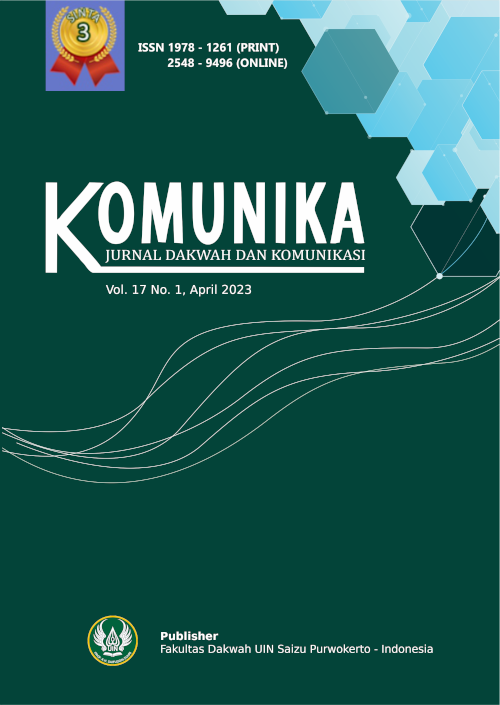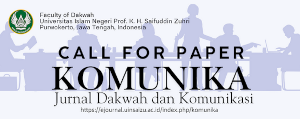New Media Disruption Towards Mainstream Media Resistance (Study of Fajar and Tribun Timur Daily in Makassar City)
DOI:
https://doi.org/10.24090/komunika.v17i1.7542Keywords:
Media disruption, New media, Mainstream media, Media resistanceAbstract
The phenomenon of disruption penetrates all lines of life. Technological advances influence almost all human activities and activities. Conventional media loyal to their old style will slowly lose their fans. The methodology used in this study is qualitative-descriptive, with a case study approach consisting of several cases in Fajar & Tribun Timur Makassar using a purposive sampling technique. This study's results indicate decreased newspaper readers, but print media advertising growth is still growing. Some factors affected were the decline in circulation turnover triggered by a decline in public interest in reading Beria through print media. The strategy is digitizing newspapers through e-papers, content innovation, networking, and organizational restructuring. The disruption of new media by the Fajar & Tribun Timur newspaper industry managers process opportunities and threats. Opportunities in question are 1) the Strength of human resources in providing accurate information to the public. 2) Establish collaboration with stakeholders. 3) The company's management's Strength in response to journalistic style changes. 4) Technology Development. While the threats faced are 1) The presence of new media. 2) The speed of new media in providing information compared to the mainstream media. 3) High costs and 4) Business competitors. The electronic world is full of creations and cyber-journalistic abilities that can be combined in synergy with print media. This step can only be done if the leadership of this new media is controlled by a team that has technological, management, and cyber journalistic skills that are highly competitive in information competition.Downloads
References
Beckett, C., & Deuze, M. (2016). On the role of emotion in the future of journalism. Social media+ society, 2(3), 2056305116662395.
Blumler, J.G. and Katz, E. (1974) The Uses of Mass Communications: Current Perspectives on Gratifications Research. Sage Annual Reviews of Communication Research, Volume 3
Cangara, Hafied. 2016. Pengantar Ilmu Komunikasi. Jakarta PT. Rajagrafindo Persada
Christensen, B. (2014). Building a Network for the Internet of Things with the Constrained Application Protocol. The University of Waikato, PhD Thesis2014.
Christensen, C. (1997). The Innovator’ s Dilemma; When New Technologies Cause Great Firms to Fail. President and Fellows of Harvard College
Colombo, F. (2019). Media And Communication In Italy: Historical And Theoretical Perspectives.
Creeber, G., & Martin, R. (2008). Digital culture: Understanding new media: Understanding new media. McGraw-Hill Education (UK).
Creswell, J. W., & Poth, C. N. (2016). Qualitative inquiry and research design: Choosing among five approaches. Sage publications.
Evans, E. (2011). Transmedia television: Audiences, new media, and daily life. Routledge.
Hennig-Thurau, T., Malthouse, E. C., Friege, C., Gensler, S., Lobschat, L., Rangaswamy, A., & Skiera, B. (2010). The impact of new media on customer relationships. Journal of service research, 13(3), 311-330.
Hidayatullah, F., Farid, M., & Afifah, N. N. (2022). Pemanfaatan Influencer Sebagai Media Promosi Pariwisata Sulawesi Selatan Pada Akun Instagram@ Visitsulsel. Id. Avant Garde, 10(2), 272-284.
Howard, P. N. (2010). The digital origins of dictatorship and democracy: Information technology and political Islam. Oxford University Press. https://www.jatimtech.com/apa-itu-facebook-55288
Kasali, R. (2017). Disruption" Tak ada yang tak bisa diubah sebelum dihadapi motvasi saja tidak cukup".
Miles, M. B., Huberman, A. M., & Saldaña, J. (2018). Qualitative data analysis: A methods sourcebook. Sage publications.
Mustofa, M. B., Shiddiq, F., Miftakhudin, K., Rahmawati, H., & Wuryan, S. (2022). Utilization of Social Media in Building Personal Branding for Career Women in the Society 5.0 Era. KOMUNIKA: Jurnal Dakwah dan Komunikasi, 16(1), 83-93.
Owen, T. (2015). Disruptive power: The crisis of the state in the digital age. Oxford Studies in Digital Poli.
Pangesti, R. P. (2021). Implementasi Komunikasi Pemasaran Produk Co-Branding Starcross X Anggur Orang Tua (Doctoral dissertation, Universitas Atma Jaya Yogyakarta).
Puig De La Bellacasa, M. (2015). Making time for soil: Technoscientific futurity and the pace of care. Social studies of science, 45(5), 691-716.
Rahayu, L., Arfan, A., & Batubara, A. (2021). Penerapan Kode Etik Jurnalistik Dalam Meningkatkan Profesionalitas Wartawan Di Surat Kabar Harian Jambi Ekspres (Studi Pasal 1 Dan 2 Profesionalitas Wartawan) (Doctoral dissertation, UIN Sulthan Thaha Saifuddin Jambi).
Rifkin, J. (2014). The zero marginal cost society: The internet of things, the collaborative commons, and the eclipse of capitalism. St. Martin's Press.
Romli, A. S. M. (2018). Jurnalistik online: Panduan mengelola media online. Nuansa Cendekia.
Rumata, V. M. (2018). Digitalisasi dan Eksistensi Media Cetak (Studi Kualitatif Majalah Go Girl dan Harian Suara Pembaharuan). KOMUNIKOLOGI: Jurnal Ilmiah Ilmu Komunikasi, 15(2)
Setyawan, Irwan. (2013). Media cetak bertahan hidup (strategi jawa pos indonesia dan the straits times Singapura mempertahankan eksistensinya dari gempuran media online). Prosiding seminar besar komunikasi @2014, Padang: 25 – 27 November 2013, 702-711.
Downloads
Published
Issue
Section
License
Copyright (c) 2023 Erniwati, Andi Alimuddin Unde, Hafied Cangara, Fauzan Hidayatullah

This work is licensed under a Creative Commons Attribution-ShareAlike 4.0 International License.
Authors who publish with this journal agree to the following terms:
- Authors retain copyright and grant the journal right of first publication with the work simultaneously licensed under a Creative Commons Attribution-ShareAlike 4.0 International License that allows others to share the work with an acknowledgement of the work's authorship and initial publication in this journal.
- Authors are able to enter into separate, additional contractual arrangements for the non-exclusive distribution of the journal's published version of the work (e.g., post it to an institutional repository or publish it in a book), with an acknowledgement of its initial publication in this journal.
- Authors are permitted and encouraged to post their work online (e.g., in institutional repositories or on their website) prior to and during the submission process, as it can lead to productive exchanges, as well as earlier and greater citation of published work (See The Effect of Open Access).

























